|
History of PowerVR graphics cards
yjfy
The company was founded in 1985 by Tony Maclaren, and
subsequently led by him as Group Chief Executive, as VideoLogic and
originally focused on graphics, sound acceleration, home audio systems,
video-capture and video-conferencing systems.VideoLogicr's GraphixStar
series of graphics cards have a small reputation.
1.PowerVR Series
1
In 1992, VideoLogic began independent research and development of
PowerVR related graphics technology. In December 1994, it sought to
cooperate with NEC. On March 23, 1995, VideoLogic licensed its new
technology called PowerVR to NEC, and NEC took a stake and held 2.29% of
the shares.
The initial target for PowerVR Series1 was arcade
systems.VideoLogic also created PC-based solutions in conjunction with
NEC.At the end of 1995, Midas 3, the first product of PowerVR Series1,
was successfully developed. Midas 3 is highly integrated and transformed
into PCX1, and the 0.5 micron process of PCX1 is improved to 0.35 micron
to become PCX2. The 3D performance of Midas 3 is between PCX1 and PCX2.
PowerVR Series1 3D performance is stronger than Rendition Vérité V1000,
and weaker than 3Dfx Voodoo.The market share of PowerVR series 1 was
once second only to Voodoo.
1.1 Midas 3
Midas 3 is the first product of the PowerVR series, which is combined by
Image Synthesis Processor (ISP, Sabre) and Texture and Shading Processor
(TSP, TexAS), and a bridge chip. ISP is scalable, and the arcade machine
can even use two or four ISPs. The PC uses a 3-chip structure with a
single ISP and TSP configuration.
Midas3 is 3-chip and uses a split memory architecture: 1 MB 32-bit
SDRAM (240 MB/s peak bandwidth) for textures and 1 MB 16-bit FPM DRAM
for geometry data (PCI communication). .Core clock/Memory
clock:66Mhz,66Mpixels/s fillrate,66Mtexels/s fillrate.Unlike
other 3D daughter cards, it abandons the VGA interface,pushed the pixel
output over the PCI bus and directly into the 2D card display.
1.1.1 Midas 3
PCB#00QU-3.8/1
Midas 3 is manufactured by VideoLogic, and NEC's model is MC-301. Only
Midas 3 is used in Presario 8000 series multimedia and PC enthusiast
machines released by Compaq on July 17, 1996.
Midas 3
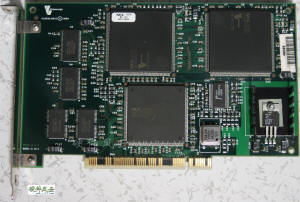
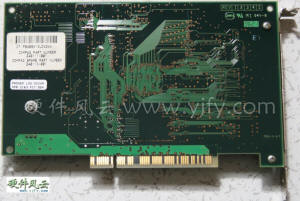
1.1.2 Midas Prototype
This Midas Prototype is an image released by Imagination to commemorate
the 25th anniversary of PowerVR. Due to the age, Imagination internal
staff can no longer tell whether it is Midas 1 or Midas 2. I think it is
Midas 2 because of its high degree of completion. It is a product
evaluation board, and Midas 1 should be a chip evaluation board.
Midas 2 needs to be connected to the 2D card in the computer via a VGA
cable to superimpose the 3D image. Just like the Voodoo card of 3DFX
later, this design will lead to too high product cost. Midas 3
eliminates the image input and output sockets and its auxiliary
circuits, and uses the PCI interface to transmit 3D images to the 2D
graphics card, saving costs.
Midas 2
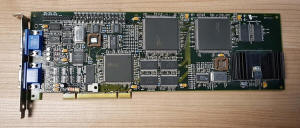
(From Imaginationtech.com) |
1.2.PCX1(Midas
4)
NEC and VideoLogic announced PCX1 on May 9, 1996. In fact, PCX1 is the
product of integrating Midas 3's three chips into one chip. PCX1 adopts
0.5 micron process, PCI interface 3D daughter card, 64bit video memory,
4MB, the core and video memory operating frequency is about 60Mhz,
66Mpixels/s fillrate, 66Mtexels/s fillrate, single rendering pipeline,
single cycle, single texture. PCX1 uses TBR technology, which is an
important feature in the technology of the PowerVR series of chips, the
full name is Tile Based Deferred Rendering. Although PowerVR is not the
first company to adopt this rendering method, it has successfully
applied this rendering method to its products.
1.2.1
Apocalypse 3D
On January 31,
1997, VideoLogic began to sell Apocalypse 3D, a graphics card based on
PowerVR that brings arcade-level 3D performance to PCs at a price of
less than $200. Compaq's popular Presario PC series uses it more.
1.2.1.1
Engineering sample
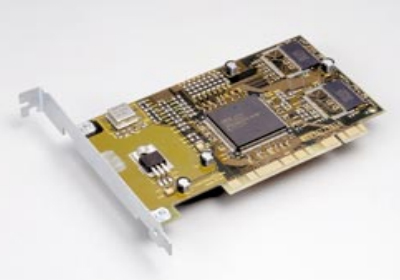
1.2.1.2
Official product
PCB#00RD-3.8/2
The Apocalypse 3D
of the PCX1 chip is manufactured by VideoLogic, and the model of NEC is
MC-302.
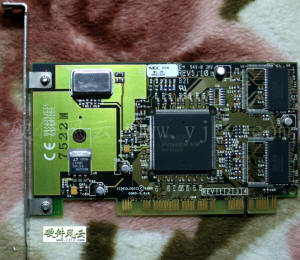
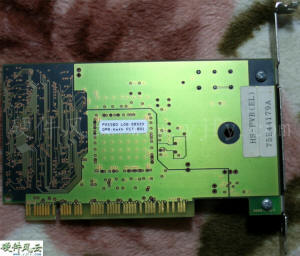
1.2.2
GA-GM3D4/PCI
Under the influence of NEC, the Japanese market not only has
manufacturers put into production, but also has a large number of
players. I-O DATA has become an important partner.
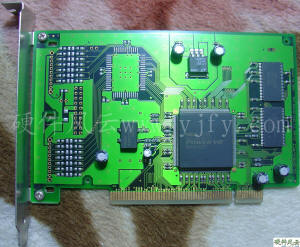
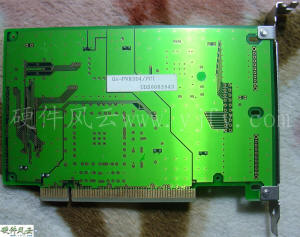 |
|
1.3.PCX2(Midas
5)
April 7, 1997-NEC and VideoLogic announced the launch of the PCX2 3D
graphics accelerator. PCX2 uses 0.35 microns, 64bit video memory, 4MB,
the core and video memory operating frequency 66Mhz, 66Mpixels/s
fillrate, 66Mtexels/s fillrate, single rendering pipeline, single cycle,
single texture.
1.3.1
Apocalypse 3DX
On April 14, 1997, VideoLogic launched the Apocalypse 3Dx graphics
accelerator card based on the PCX2 chip.
The performance of PCX2 has been improved to a certain extent than that
of PCX1. It works well when running Quake2 optimized for them. The
hardware indicators also outperform Voodoo, reaching a filling speed of
1.2 million polygons per second and 66 million pixels. In the same era
The product is second to none. At the same time, it supports D3D,
OpengGL, and SGL. SGL is a subset of OpenGL and has been specially
extended for PowerVR. However, in actual use, due to compatibility
issues caused by the driver, many games have problems running and
require high CPU requirements.
1.2.1.1
Engineering sample
PCB#00RR-3.8/1
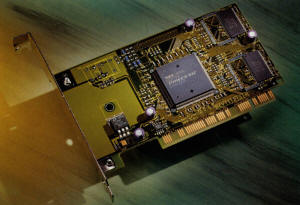
(From Next
Generation)
1.2.1.1
Official product
PCB#00RR-3.8/4
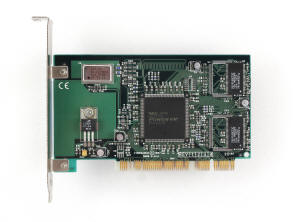
(From vgamuseum.ru)
1.3.2 Apocalypse 5D
On June 9, 1997, NEC and Tseng Labs formed a strategic alliance. On
September 4, it announced the launch of the Apocalypse 5D graphics card
based on the PCX2 3D accelerator and the Tseng Labs ET6100 2D display
chip. There are 6 MB versions (4 MB SDRAM texture memory and 2 MB MDRAM
frame buffer memory) and 8 MB versions (4 MB SDRAM and 4 MB MDRAM).
1.2.1.1
Engineering sample
Use Tseng Labs ET6000 2D display chip.
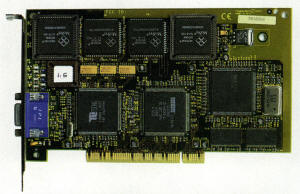
(From Next
Generation)
1.2.1.1
Official product
PCB#00RT-3.8/3
Use Tseng Labs
ET6100 2D display chip.
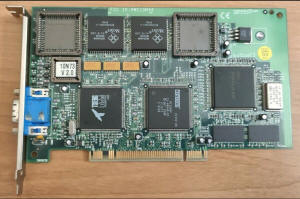
(From westster.top)
1.3.3 Apocalypse 5D sonic
PCB#00RS-3.8/4
Combining the 3D acceleration of Apocalypse 3Dx, the stunning 2D
performance of Tseng Labs' ET6100, and the sensational audio quality of
SonicStorm(ESS Agogo-XP) on a single PCI card.
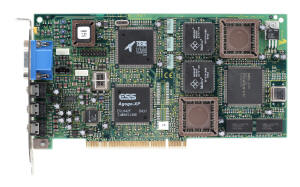
(From vgamuseum.ru)
1.3.4 PC 3DEngine
NEC designs and
manufactures PC 3DEngine (PWH-6030) by itself.
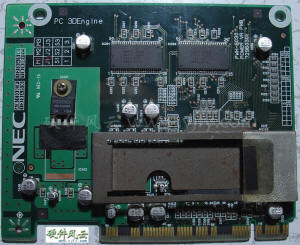
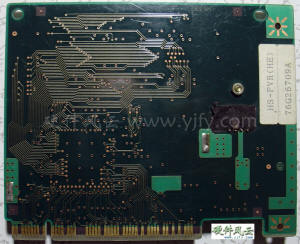
1.3.5 M3D
On August 22, 1997, Matrox Graphics Inc. announced a strategic alliance
with NEC Electronics Inc. to launch M3D.
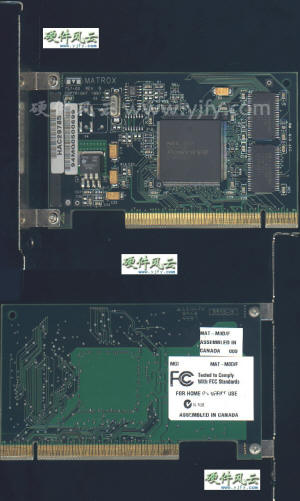
1.3.6
IF-SEGA2/PCI-1
IF-SEGA2/PCI-1 of I-O
DATA has Sega gamepad interface.
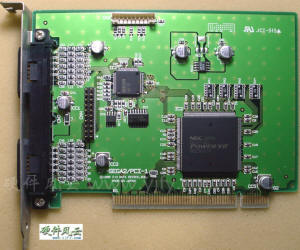 |
|
2. PowerVR Series2
In July 1997, PowerVR Series2 defeated 3DFX Voodoo2 to become the
graphics processor of the Sega Dreamcast game console. In February 1998,
the DC version of PowerVR2DC (CLX2) was successfully developed. The core
frequency is 100 MHz, 5 million polygons/second, and 100 to 300 million
pixels/second. On November 27, 1998, Sega Dreamcast with integrated
PowerVR2DC was launched in Japan.
COMDEX on December 2, 1998 just ended, NEC and Videologic announced the
PC version of Neon 250 (PMX1). Since NEC's focus is on the development
of DC version products, and its enthusiasm for porting to PCs is not
high, some cracks have appeared in the cooperation with Videologic. The
Neon 250 was delayed until August 31, 1999. Only Videologic has
manufactured the Neon 250 graphics card, and it has a small number of
sales in the UK and its online store. Compared with PowerVR2DC, the
performance of Neon 250 has shrunk a lot, but its unique TBR technology
integrated in the Neon250 display chip effectively reduces the burden on
the CPU, and the performance is still close to that of TNT2 graphics
cards. Neon 250 core and video memory are 125Mhz, 12Mpixels/s fillrate,
12Mtexels/s fillrate. It adopts SDRAM, 64bit, 32MB video memory, 1
rendering pipeline, and each pipeline has a single texture unit. It has
250Mhz RAMDAC, supports OpenGL (mini-GL), SGL, DirectX6.
2.1 Prototype
2.1.1 ARC1
The code name for
the development of the Sega Dreamcast project is Katana. The PC Card in
the Katana set 1 development kit (PWH-6031) is based on PCX2, and the PC
Card in the Katana set 2 development kit is ARC1 (PWH-6032). The design
of ARC1 seems to be based on Midas 3 and PCX2, including a Midas 3 ISP
Chip and a chip designed to be updated on the basis of PCX2, Still a 3D
daughter card. Katana set 3 development kit and Katana set 4 development
kit are still dual chips similar to ARC1, but moved from PC Card to PC
Board CLX1. In essence, it still belongs to PowerVR Series 1. The
single-chip CLX2 integrated in the Katana set 5 development kit in
February 1998 is PowerVR2DC.
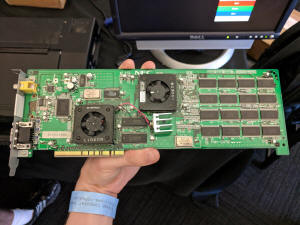
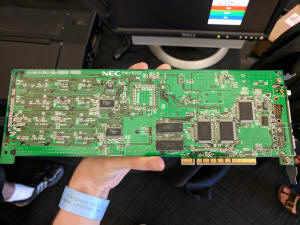
(From shibe ꜰᴩɢᴀ expert)
2.1.2 PMX1
PowerVR Series 2
started with 2D display.
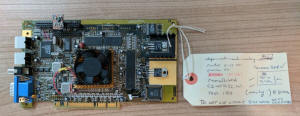
(From Imaginationtech.com)
2.2 Neon250 AGP
2.2.1 Engineering
sample
The Neon250 AGP
graphics card in the official promotional picture is the Engineering
sample.
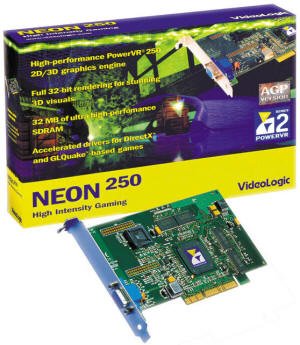
2.2.2
Official product
PCB#00TD-3.8/1
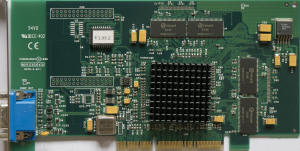
(From Pepino)
2.3 Neon250 PCI
PCB#00TD-3.8/3
The performance
of Neon250's PCI interface version is slightly weaker than that of AGP
interface version.
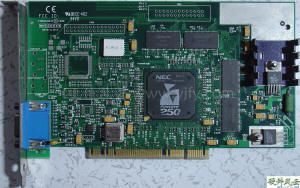
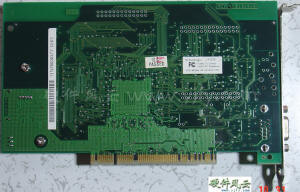 |
|
2. PowerVR Series3
8 APRIL
1999,VideoLogic Group Plc (VideoLogic), the international multimedia
and graphics company, today announced that it has agreed a strategic
partnership with STMicroelectronics (formerly known as SGS-THOMSON
Microelectronics) to license VideoLogic’s PowerVR 2D/3D graphics
technology for the development and manufacture of a range of high
performance PC graphics and video accelerators.
VideoLogic changes name to Imagination Technologies.VideoLogic
Systems and PowerVR Technology to operate as Divisions.
3.1 Kyro
On June 5, 2000, Imagination announced Kyro (PowerVR third
generation), authorized ST Microelectronics to manufacture. Kyro
core codenamed STG 4000X, adopts 0.25 micron process, 12 million
transistors, display core and video memory are 125Mhz, 250Mpixels/s
fillrate, 250Mtexels/s fillrate, 128bit 32/64MB SDRAM video memory.
270Mhz RAMDAC, 2×1 pipeline architecture is a dual-pipeline
single-texture unit. Support DX6, EMBM (environment bump map).
Continue to use TBR technology to overcome the weakness of not
supporting hardware T&L. The performance of its dual-pipeline
single-texture unit is not as good as the Geforce 256, let alone the
Geforce2 GTS of the same period.
Kyro's core size is small, and the heat generation is also small.
The number of transistors is also significantly lower than that of
nVidia's products in the same period, which has a higher cost
performance. Adopting its chips are VideoLogic Vivid!, Hercules 3D
Prophet 4000, Inno3D KYRO 2000, PowerColor Evil Kyro, etc. However,
the driver is still not perfect, and sometimes incompatibility and
crashes may occur.
3.1.1 Vivid!
3.1.1.1
Engineering sample
PCB#00UD-3.11/1
Reference
board.
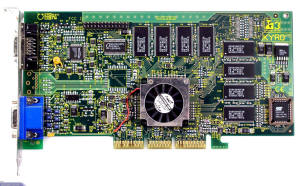
(From
IXBT.com)
3.1.1.2
Official product
PCB#00UD-3.11/4
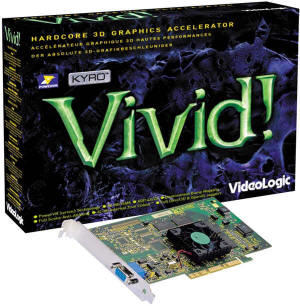
3.1.2 3D PROPHET 4000XT PCI
Hercules designed it himself.
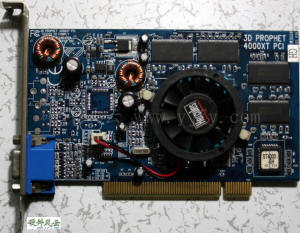
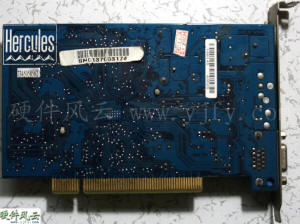
3.1.3 Avenger 4000Kyro
Use reference design.
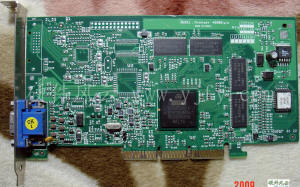
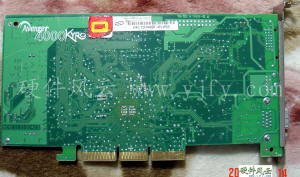 |
|
3.2 Kyro II
On March 12, 2001, Kyro II was launched, the core code is STG 4500,
using 0.18 micron process, 15 million transistors, core and video
memory frequency increased to 175Mhz, 350Mpixels/s fillrate,
350Mtexels/s fillrate, 128bit 32/64MB SDRAM video memory, Double
pipeline single texture unit. Kyro II was known as the MX400 killer
in the European market at the time, and its performance was weaker
than Geforce2 GTS, not to mention the Kyro II rival Geforce3 in the
same period. The problem with Kyro II is that the rendering pipeline
is too small, the fill rate is limited, and the video memory
bandwidth provided by the outdated SDR video memory limits the
performance. More importantly, Kyro II still fails to support
hardware T&L, and relying on part of the software T&L to try to gain
a foothold in the GPU competition has become an impossible task.
KYRO II supports highly efficient Full Scene Anti-Aliasing,
Internal True Color , and Environmental and Dot3 Bump mapping. With
an exclusive feature set including support for 8-layer
multi-texturing, Z32 and ConstantStencil .
KYRO II also includes a fast 128-bit 2D engine, hardware video
playback and DVD decode assistance, AGP Bus Master Interface, a
128-bit SGRAM/SDRAM interface with up to 64 Mbyte support, and
integrated Palette DAC. A video input port allows connection to a
wide range of video source and capture peripherals, while a digital
video output port provides glueless connection to flat panel
displays and TV encoders.
3.2.1
Vivid!XS
3.2.1.1
Prototype
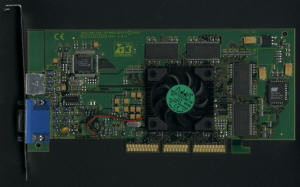
(From
beyond3d.com)
3.2.1.2
Qualification Sample
PCB#00VA-3.11/6
Except for
the heat dissipation part, it is no different from the official
product.
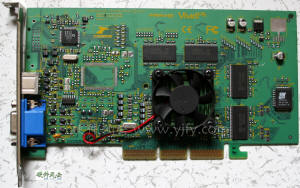
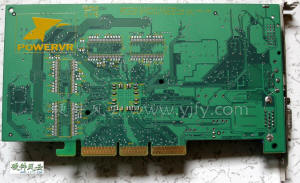
Later revised
to PCB#00VA-3.11/7
3.2.1.2
Official product
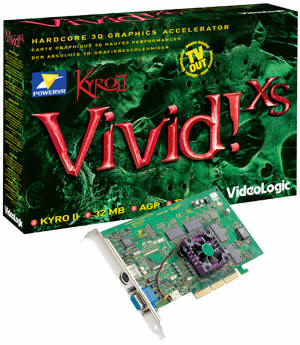
3.2.2 3D PROPHET 4500
Use the reference design of PCB#00VA-3.11/4. Hercules also has a
self-designed version.
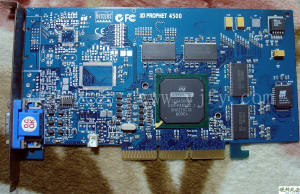
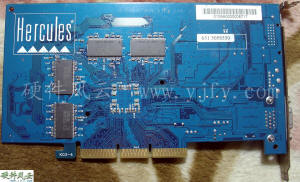
3.2.3 Avenger 4500Kyro
Use the
reference design of PCB#00VA-3.11/6.
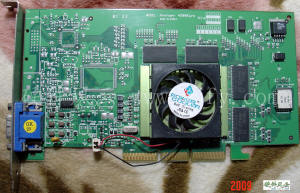
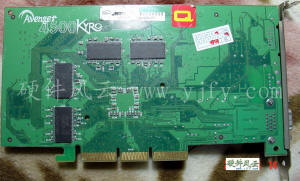
3.2.4
Pixel Perfect GC-K2P-64
Pixel Perfect Display Manager is now able to control up to 9
separate displays all of which may be running at different
resolutions and orientations (portrait or landscape). In addition it
is possible to mix wide-screen and standard 4:3 resolutions and even
support panels from several manufacturers requiring different timing
specifications simultaneously. Individual control for orbiter and
burn reduction features is also supported.
PCB#00WB-3.11/2 REV 1
The PCB date is 0221 weeks and the PCB is blue.
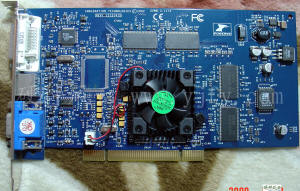
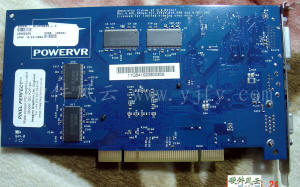
PCB#00WB-3.11/2 REV 2
The PCB date is 0334 weeks, and the PCB color is green, which is
often used by Imagination/Vodeologic.
PCB#00WB-3.11/2.1
The PCB date
is 0536 weeks and has been operated by Pixels UK Ltd.
The PCB# of
Pixel Perfect GC-K2A-64 may be 00WB-3.11/1, AGP interface, I have
not seen the real object and picture.Maybe GC-K2A-64 and GC-K2P-64
board types are prepared for Kyro II SE.Kyro II graphics card has
such a long life, which has a lot to do with the failure of Kyro II
SE. |
|
3.3 Kyro II SE
On March 13, 2002, at CeBIT 2002, PowerVR Technologies of
Imagination Technologies announced KyroII SE, the core code name is
STG 4800. According to published information, compared to Kyro II,
its core and video memory frequency has been increased to
200Mhz.KYRO II SE supports the new EnT&L driver technology which
unites the advanced features of KYRO II SE with transform.
It can be seen that KyroII SE is an overclocked version of Kyro II,
but it has been simply revised with software T&L support. Because
the development of Kyro III with hardware support for T&L is not
smooth, KyroII SE is needed to transition. KyroII SE achieves the
equivalent performance of Geforce2 GTS and GeForce4 MX 420 in the
same period.
Only Imagination's Vivid! XS Elite and Hercules' 3D Prophet 4800
were announced to use KyroII SE chip graphics cards, and they were
not on sale.
There are different opinions on why Kyro II SE chip graphics cards
are not sold. The reasons may be:
1. The main reason is that in the GPU competition, PowerVR
Technologies cannot solve the hardware T&L and is obviously at a
disadvantage in the competition. In addition, Kyro II SE is almost
an overclocked version of Kyro II, with low reliability.
2. STMicroelectronics closed its corresponding graphics department
and decoupled from Imagination.
3. Due to the unique rendering system, Kyro series graphics cards
can obtain excellent 3D performance and picture effects at a lower
cost, which is suppressed by nVidia and ATi.
Fourth, Imagination announced the Vivid! XS Elite graphics card but
not for sale, the hidden meaning is self-evident. What is
Imagination doing at this time?
At CeBIT 2002 on March 13, 2002, it also demonstrated its PowerVR
MBX core for embedded graphics applications, and Imagination's
research and development focus has shifted.
3.3.1 Vivid!XS Elite
It is slightly adjusted on the basis of PCB#00VA-3.11/7. The most
obvious change is to adjust the position of the Focus TV-FS451 codec
chip from horizontal to vertical. After completing the initial
design of Vivid! XS Elite, Imagination will focus on the development
of Kyro III and license the design of the Kyro II SE graphics card
to Hercules.
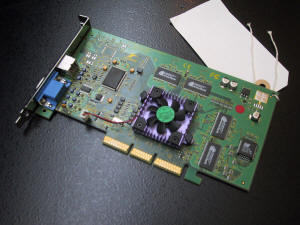
(From hardware.fr)
3.3.2 3D Prophet 4800
3.3.2.1
Prototype
PCB#00VA-3.11/11
The official
promotional image of Hercule was leaked in January 2002. The 3D
Prophet 4800 graphics card in the image was adjusted on the basis of
the Vivid! XS Elite reference board, and still uses Imagination's
PCB#.
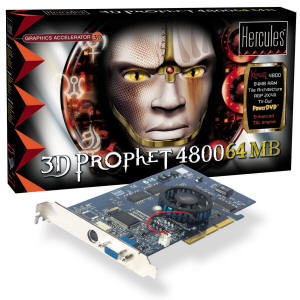
3.3.2.2
Engineering sample
PCB#00VA-3.11/12
The operating frequency of Kyro II SE has been increased from 175Mhz
of Kyro II to 200Mhz. The design scheme similar to Kyro II is no
longer sufficient. Generally speaking, Vivid! XS graphics cards only
use APL1084, and 3D Prophet 4500 graphics cards only use MIC29302.
3D Prophet 4800 graphics cards use both APL1084 and MIC29302 to
enhance the power supply circuit.
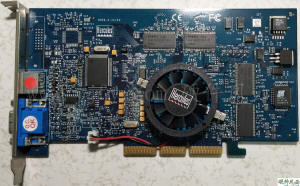
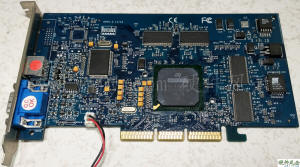
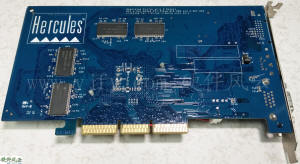
The core date and PCB date of this 3D Prophet 4800 engineering
sample are both 0216 weeks, which is mid-April 2002. The core and
video memory frequencies are defaulted to 175MHz.
In July 2002, the core date and PCB date of the 3D Prophet 4800 test
samples provided to the outside world were still 0216 weeks, but the
core and memory frequencies were increased to 200MHz, which shows
that Kyro II SE is an overclocked version of Kyro II.
As Kyro series graphics cards were suppressed by nVidia, Hercule had
to give up cooperation with nVidia. Cooperated with ATI on January
12, 2002. But ATi also can't accommodate Kyro series graphics cards,
although this design can be mass-produced, it ultimately died.
4. PowerVR Series4
The PowerVR Series4 product is Kyro III, the chip name is STG5000,
and it will be manufactured using a 0.15 micron process. The core
frequency is increased to 300MHz, equipped with 128bit DDR SDRAM
that also works at 300MHz as the video memory. Its rendering
pipeline has increased from 2 to 4 in KyroⅡ, and the supported
texture size has also been expanded from the original 1024×1024 to
the current mainstream 2048×2048, so that a more detailed and
realistic 3D surface can be obtained. In addition, Kyro III is also
the first product in the PowerVR series with a hardware T&L engine.
STMicro previously closed its dedicated graphics card processor
division.The original design of the Kyro III, would be technically
obsolete, because it would offer hardware compatibility with the
Direct3D 7 API, while NVIDIA and even then ATI were at the Direct3D
8 level.The Kyro II SE graphics card cannot be put into production,
and the outcome of the Kyro III graphics card can be imagined. This
is the end of PowerVR's PC graphics card.
Imagination Technologies moved with PowerVR architectures to the
mobile, automotive and medical markets, where it is doing well to
this day.
Thank you for the picture information! |
|